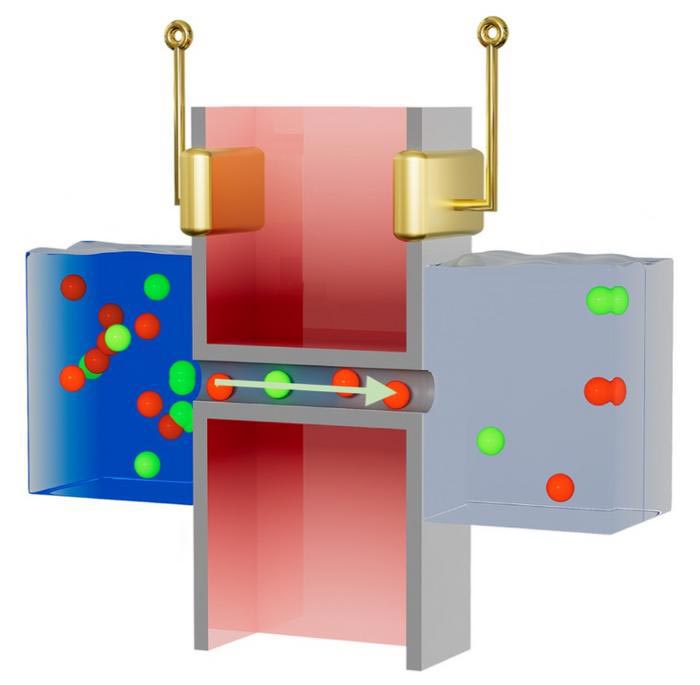Nanofluidic device generates power with saltwater

Nanofluidic device generates power with saltwater
Credit: The Grainger College of Engineering at University of Illinois Urbana-Champaign
There is a largely untapped energy source along the world’s coastlines: the difference in salinity between seawater and freshwater. A new nanodevice can harness this difference to generate power.
A team of researchers at the University of Illinois Urbana-Champaign has reported a design for a nanofluidic device capable of converting ionic flow into usable electric power in the journal Nano Energy. The team believes that their device could be used to extract power from the natural ionic flows at seawater-freshwater boundaries.
“While our design is still a concept at this stage, it is quite versatile and already shows strong potential for energy applications,” said Jean-Pierre Leburton, a U. of I. professor of electrical & computer engineering and the project lead. “It began with an academic question – ‘Can a nanoscale solid-state device extract energy from ionic flow?’ – but our design exceeded our expectations and surprised us in many ways.”
When two bodies of water with different salinity meet, such as where a river empties into an ocean, salt molecules naturally flow from higher concentration to lower concentration. The energy of these flows can be harvested because they consist of electrically charged particles called ions that form from the dissolved salt.
Leburton’s group designed a nanoscale semiconductor device that takes advantage of a phenomenon called “Coulomb drag” between flowing ions and electric charges in the device. When the ions flow through a narrow channel in the device, electric forces cause the device charges to move from one side to the other creating voltage and electric current.
The researchers found two surprising behaviors when they simulated their device. First, while they expected that Coulomb drag would primarily occur through the attractive force between opposite electric charges, the simulations indicated that the device works equally well if the electric forces are repulsive. Both positively and negatively charged ions contribute to drag.
“Just as noteworthy, our study indicates that there is an amplification effect” said Mingye Xiong, a graduate student in Leburton’s group and the study’s lead author. “Since the moving ions are so massive compared to the device charges, the ions impart large amounts of momentum to the charges, amplifying the underlying current.”
The researchers also found that these effects are independent of the specific channel configuration as well as the choice of materials, provided the channel diameter is narrow enough to ensure proximity between the ions and the charges.
The researchers are in the process of patenting their findings, and they are studying how arrays of these devices could scale for practical power generation.
“We believe that the power density of a device array could meet or exceed that of solar cells,” Leburton said. “And that’s not to mention the potential applications in other fields like biomedical sensing and nanofluidics.”
Kewei Song also contributed to this work.
The researchers’ article, “Ionic coulomb drag in nanofluidic semiconductor channels for energy harvest,” is available online. DOI: 10.1016/j.nanoen.2023.108860
Journal: Nano Energy
DOI: 10.1016/j.nanoen.2023.108860
Article Title: Ionic coulomb drag in nanofluidic semiconductor channels for energy harvest
Article Publication: Date:3-Sep-2023
Media Contact
Aaron Seidlitz
University of Illinois Grainger College of Engineering
aseid83@illinois.edu
All latest news from the category: Power and Electrical Engineering
This topic covers issues related to energy generation, conversion, transportation and consumption and how the industry is addressing the challenge of energy efficiency in general.
innovations-report provides in-depth and informative reports and articles on subjects ranging from wind energy, fuel cell technology, solar energy, geothermal energy, petroleum, gas, nuclear engineering, alternative energy and energy efficiency to fusion, hydrogen and superconductor technologies.
Newest articles

Bringing bio-inspired robots to life
Nebraska researcher Eric Markvicka gets NSF CAREER Award to pursue manufacture of novel materials for soft robotics and stretchable electronics. Engineers are increasingly eager to develop robots that mimic the…

Bella moths use poison to attract mates
Scientists are closer to finding out how. Pyrrolizidine alkaloids are as bitter and toxic as they are hard to pronounce. They’re produced by several different types of plants and are…

AI tool creates ‘synthetic’ images of cells
…for enhanced microscopy analysis. Observing individual cells through microscopes can reveal a range of important cell biological phenomena that frequently play a role in human diseases, but the process of…





















